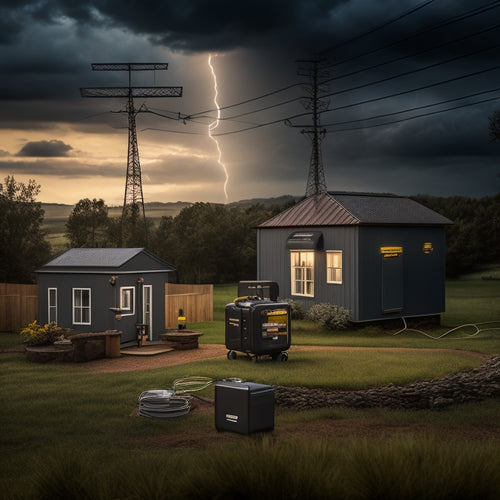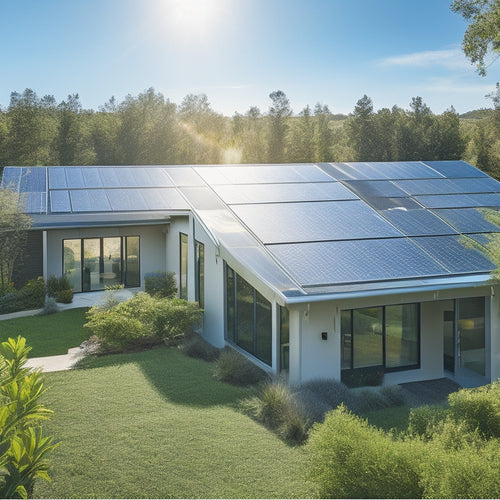
10 Tips for DIY Home Energy Freedom
Share
You're taking the first step towards energy independence by exploring DIY solutions. To achieve home energy freedom, start by evaluating your energy needs to identify high-usage areas and create a customized plan. Next, choose the right solar panel kit that meets your energy generation needs, considering panel quality, durability, and inverter performance. Plan your system configuration based on roof size, direction, and obstructions, and select efficient panels with high wattage ratings. Also, consider energy storage options, guarantee safe installation, and connect to a charge controller. By following these initial steps, you'll be well on your way to utilizing the power of the sun - and that's just the beginning of your expedition.
Overview
- Assess energy needs by evaluating consumption patterns, lifestyle habits, and energy usage during peak hours to identify areas for improvement.
- Choose high-quality solar panels with excellent durability, advanced MPPT technology, and high efficiency ratings to maximize energy harvest.
- Plan the system configuration considering roof size, direction, and sunlight exposure to optimize energy production and efficiency.
- Consider energy storage options, such as battery types and capacities, to ensure backup power during outages and optimal energy management.
- Ensure a safe and efficient installation by following safety protocols, using appropriate personal protective equipment, and adhering to local regulations.
Assess Your Energy Needs First
Before diving into DIY home energy projects, take a step back to assess your energy needs first.
You'll want to understand your energy consumption patterns to determine what changes will have the greatest effect.
Take stock of your lifestyle and habits: do you work from home or have a large family? This will help you identify areas where you can cut back on energy consumption.
Consider your energy usage during peak hours, and think about ways to reduce your reliance on the grid.
To get an accurate overview, perform a thorough energy audit to identify high usage areas and efficiency opportunities.
By understanding your energy needs, you'll be able to create a customized plan that reduces your energy bills and minimizes your lifestyle impact.
This essential step will guarantee that your DIY home energy projects are effective and efficient, giving you the freedom you desire.
Choose Right Solar Panel Kit
When selecting a solar panel kit, you'll want to prioritize high-quality panels that can withstand the elements and generate consistent energy.
Compatibility is also key - make certain the kit's components, including the inverter and mounting system, work seamlessly together.
Proper design considers energy requirements, sunlight availability, and battery capacity for reliability off-grid systems.
Panel Quality Matters
Investing in a high-quality solar panel kit is essential to utilizing the full potential of renewable energy for your home. You want to guarantee that your panel can withstand harsh weather conditions and last for decades.
Look for a kit with high-quality panels that have excellent durability. A durable panel can resist corrosion, extreme temperatures, and physical stress.
Additionally, when considering high-efficiency solar charging solutions, advanced MPPT technology can maximize energy harvest.
Pay attention to the inverter quality, as it directly affects the performance and efficiency of your solar panel system. A high-quality inverter can maximize your energy output and reduce the risk of system failure.
Kit Compatibility Essentials
Selecting the right solar panel kit for your home can be a challenging task, especially with the numerous options available in the market.
You'll need to take into account kit compatibility essentials to guarantee a seamless installation process. Start by identifying your installation requirements, including the size of your roof, local building codes, and the amount of energy you want to generate.
When choosing a kit, reflect on the system design options such as load calculations and panel configuration to guarantee peak energy production. Then, look for a kit that meets these needs.
Check the compatibility of the panels, inverters, and mounting systems to confirm they work together efficiently. Also, verify the kit's warranty and customer support in case you encounter any issues during installation or maintenance.
Plan Your System Configuration
You're about to make an essential decision that'll impact your entire DIY home energy system: configuring it to meet your specific needs.
This is where you'll determine the system layout that works best for your home. Consider the size and layout of your roof, as well as any obstructions that might affect energy optimization.
Think about the direction your roof faces and how much sunlight it receives daily.
You'll also need to decide on the system's electrical design, including the type and number of inverters, and how they'll connect to your electrical panel.
A well-planned system configuration guarantees maximum energy production and efficiency, saving you time and money in the long run.
Select Efficient Solar Panels
When selecting solar panels, you'll want to prioritize efficiency to maximize your energy output.
Look for panels with high efficiency ratings, typically above 20%, to guarantee you're getting the most bang for your buck.
Additionally, consider budget-friendly options that still offer reliable performance, as you don't need to break the bank to achieve significant energy savings.
Panel Efficiency Ratings
How much power can you really expect from your solar panels? The answer lies in their efficiency ratings. You want to maximize your energy output, and panel technology plays a significant role in achieving that. Higher efficiency ratings mean more power per hour of sunlight.
| Panel Type | Efficiency Rating | Power Output |
|---|---|---|
| Monocrystalline | 20-22% | 300-350 W |
| Polycrystalline | 18-20% | 250-300 W |
| Thin-Film | 7-14% | 100-200 W |
When choosing solar panels, consider the efficiency ratings and the type of panel technology used. Higher efficiency ratings may come at a higher cost, but they'll give you more power in the long run. By selecting efficient solar panels, you'll be one step closer to achieving energy freedom.
Budget-Friendly Options
Most homeowners considering solar energy face a common dilemma: balancing efficiency with affordability. You want to utilize the power of the sun without breaking the bank.
Fortunately, you can achieve energy freedom without sacrificing your budget. Start by selecting efficient solar panels that offer the best bang for your buck. Look for panels with high wattage ratings and durable construction.
Additionally, optimize your home's energy efficiency by investing in energy saving appliances and proper home insulation. This will reduce your overall energy consumption, allowing you to generate more power with fewer panels.
Consider Energy Storage Options
Your energy-efficient home setup is generating power, but what happens when the sun sets or the wind dies down? That's where energy storage options come in. You'll need a reliable system to store excess energy for later use.
| Energy Storage Options | Key Considerations |
|---|---|
| Battery Types | Lead-acid, lithium-ion, or saltwater batteries; each has pros and cons |
| Inverter Selection | Verify compatibility with your system and consider grid integration |
| Backup Systems | Determine your needs for backup power during outages |
When selecting energy storage options, consider factors like storage capacity, technology advancements, cost considerations, installation requirements, and maintenance tips. It's crucial to monitor your system's performance to guarantee peak energy freedom. By choosing the right energy storage solution, you'll be able to enjoy uninterrupted power whenever you need it.
Prepare Your Roof for Installation
Now that you've chosen the right energy storage solution, it's time to prepare your roof for installation.
Start by conducting a thorough roof inspection to identify any damaged, rotten, or missing shingles, and repair or replace them as needed.
Confirm your roof's structural integrity by checking for any signs of sagging, unevenness, or weakness.
Apply weatherproofing techniques, such as sealing gaps and cracks, to prevent water damage.
Next, consider the mounting options for your energy system, taking into consideration your roof's size, shape, and material.
Choose a mounting system that's compatible with your roof type and guarantees a secure, watertight installation.
Install Solar Panels Safely
Three critical safety considerations should guide your solar panel installation: electrical safety, fall protection, and structural integrity.
When working with electricity, verify you're familiar with the National Electric Code (NEC) and local regulations. Wear protective gear, including gloves, safety glasses, and a hard hat, to prevent electrical shock and falls.
Use installation tools, such as a ladder stabilizer and roof anchor, to secure yourself and prevent accidents. Always maintain three points of contact with the ladder or roof to prevent slipping.
Take regular breaks to rest and rehydrate, especially when working in direct sunlight.
Connect to a Charge Controller
Having guaranteed the safe installation of your solar panels, you're ready to connect them to a charge controller. This vital component regulates the energy flow from your solar panels to your battery bank, preventing overcharging or undercharging. There are two main charge controller types: PWM (Pulse Width Modulation) and MPPT (Maximum Power Point Tracking). PWM controllers are cost-effective, while MPPT controllers offer higher efficiency.
| Charge Controller Type | Installation Tips |
|---|---|
| PWM | Make sure proper ventilation to prevent overheating |
| MPPT | Install in a shaded area to prevent thermal stress |
| Both | Ground the controller to the frame of your solar panel |
| Both | Follow the manufacturer's instructions for wiring and configuration |
Monitor Your Energy Production
With your solar panel system up and running, it's essential to keep tabs on its performance to confirm you're getting the most out of your investment.
You'll want to track your energy production to verify your system is operating at peak efficiency. Invest in an energy monitoring system that provides real-time data on your energy production. This will allow you to identify any issues and make adjustments as needed.
Production tracking will also help you optimize your energy usage, reducing your reliance on the grid and maximizing your energy freedom.
Maintain Your Solar System
As you enjoy the benefits of your solar panel system, remember that regular maintenance is crucial to assure its peak performance and longevity.
You'll want to perform routine solar panel maintenance to confirm your system operates at its best. Start by visually inspecting your panels for debris, dirt, or damage. Clean your panels regularly to maximize energy production.
Also, conduct system performance checks to identify any issues. Check your inverter's display for error messages or alerts, and verify that your system is generating power as expected.
Frequently Asked Questions
Can I Install Solar Panels on a Metal Roof?
You can install solar panels on a metal roof, but you'll need to take into account the roof's material, gauge, and fastening system to guarantee a secure and waterproof installation.
How Do I Handle Snow on My Solar Panels?
You're not alone in worrying about snow on your solar panels - did you know 70% of the world's snowfall occurs in the Northern Hemisphere? To maintain panel efficiency, clear snow regularly using a soft-bristled brush or snow rake, and consider investing in a snow removal system for maximum energy production.
Are Solar Panels Resistant to Hail Damage?
You'll be relieved to know that most solar panels are designed with hail resistance in mind, ensuring they can withstand rough weather conditions; in fact, many manufacturers test their panels for solar durability against hailstones up to 1 inch in diameter.
Can I Use Solar Panels to Charge My Electric Vehicle?
Reveal the secret to a guilt-free ride! You can utilize the sun's energy to fuel your EV, enjoying solar charging's eco-friendly benefits. With a compatible system, you'll be cruising emission-free in no time, reaping EV benefits like lower operating costs and a clearer conscience.
Do Solar Panels Work During a Power Outage?
You're wondering if solar panels work during a power outage - the short answer is no, unless you have a battery backup system, which can enhance solar panel efficiency and provide reliable power outage solutions when you need them most.
Ready to Buy
As you commence your DIY home energy freedom expedition, remember that every watt counts. By following these 10 tips, you'll be utilizing the sun's golden rays to power your home in no time. Your energy independence will bloom like a sunflower, tall and proud, as you bask in the warmth of self-sufficiency. So, get ready to flip the switch on your electric bill and welcome the bright future of renewable energy!
Related Posts
-

Key Components of a Reliable Emergency Power Supply System
A reliable emergency power supply system requires several key components. You need proven performance metrics to guar...
-

Smart Grid Technology Implementation Challenges
You'll encounter several challenges when implementing smart grid technology, particularly in cost management, scalabi...
-

Installing Metal Solar Roofs for Maximum Energy Efficiency
Installing metal solar roofs can drastically enhance your home's energy efficiency and durability. These roofs withst...


